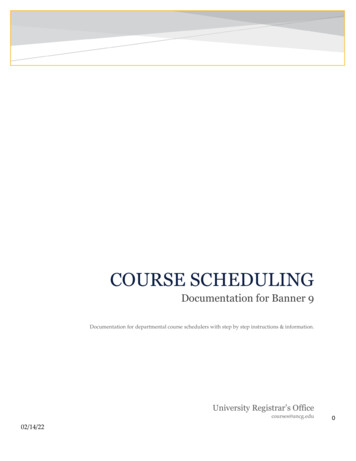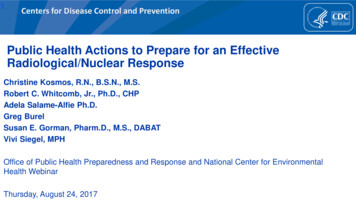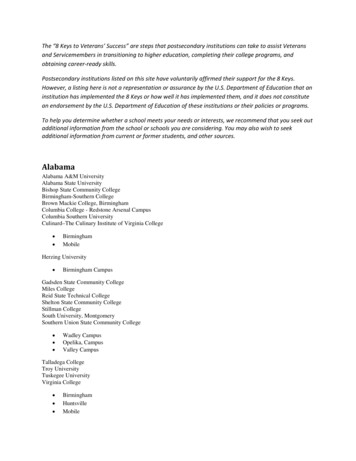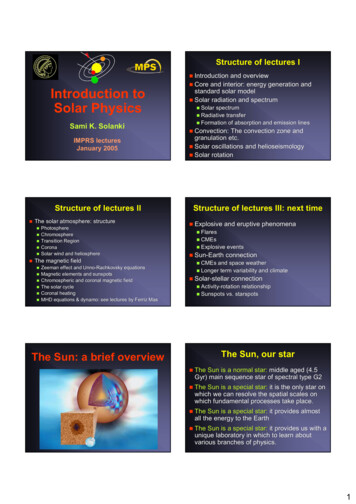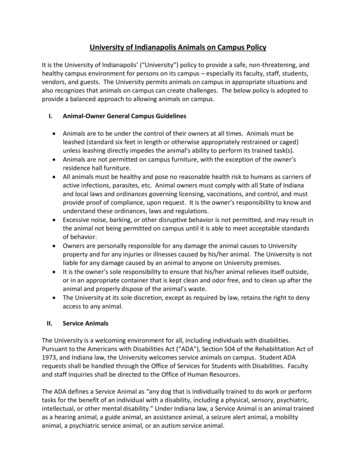
Transcription
Beutenberg Campus /IMPRS‐gBGC WorkshopMethod and Concept Transfer9th June 2011 13:00 – onwardsLecture Hall, Abbe Center BeutenbergThe aim of this workshop is to inspire interdisciplinary coopera?on and networking.The presenta?ons can either have a methodological or a conceptual approach. Theidea is to establish contacts between scien?sts with complementary skills and needs.Organisers: Dr. Susanne Erland, Beutenberg Campus & Anna Görner, IMPRS‐gBGCPROGRAM :13:00 Prof. Dr. Hartmut Bartelt (Chairman of BeutenbergCampus Jena e.V.)WELCOME ADDRESS and Chair of sessionsMax-Planck-Institutfür BiogeochemieSession 1:13:10 Dr. Valérie Schwab‐Lavrič (MPI‐BGC)Purifica?on of molecular compounds for subsequent isotopicanalysis using high‐performance liquid chromatography–massspectrometry13:35 Dr. Torsten Frosch (IPHT)Gassensing and Fiber sensors14:00 Dr. Benjamin Dietzek (IPHT) Campus Award Winner 2011Molecules in mo?on ‐ How dynamics lead to func?on14:25 Coffee BreakSession 2:14:45 Dr. Nils Hartmann (FLI)The short‐lived fish Nothobranchius furzeri as a model for ageresearch15:10 Dr. Hanna Heidel‐Fischer (MPI‐CE)Old genes meet new technologies: Revealing the evolu?on ofbu erfly genes via selected sequencing approachesSession 3:15.35 POSTERS with Refreshments
Purification of molecular compounds for subsequent isotopicanalysis using high-performance liquid chromatography–mass spectrometryValérie F. Schwab-LavričMax Planck Institute of Biogeochemistry (MPI-BGC), Jenae-mail: vschwab@bgc-jena.mpg.deSince the first gas chromatograph–isotope ratio mass spectrometer systems (GC–IRMS) became commercially available, compound-specific isotope analyses (CSIA)have proven to be a valuable tool in environmental researches [e.g. 1;2]. However,such studies are often hampered by the difficulty to separated GC-amenablecompounds (e.g., terpenoids, sterols, hopanols) with similar molecular weight,polarity and volatility which results in densely populated gas chromatograms that arenot suitable for analysis by GC–IRMS requiring baseline separation of analytes.Consequently, compounds must have been substantially pre-purified prior to amongstothersmultiplechromatographic urea adduction and column or thin-layer chromatography withAgNO3-adducted silica gel, are often complicated, time consuming and difficult toperform in a reproducible manner. Results are often not satisfactory, with lowrecoveries and the potential for isotope fractionation during workup.High-performance liquid chromatography (HPLC) provides a substantiallyhigher resolution than column or thin-layer chromatography. Separations can beperformed in a reproducible manner and sample injection can be automated. HPLCcoupled to mass spectrometer and fraction collector allows compound collectionbased on mass or elution time and offers a highly valuable tool for compoundpurification. Here, we present methods for purifying various sterols and alkenonesfrom sediment lipid extracts with (semi)-preparative-HPLC–MS (APCI) [3]. Themethods were developed to minimize sample handling and maximize recovery sothat CSIA could be performed on compound-deficient samples. We also presentevidence that substantial hydrogen isotope fractionation can occur across an HPLCpeak. Measurements of δD values across individual HPLC peaks of standardsdemonstrate the necessity of collecting at least 92% of the peak in order to maintainisotopic integrity of the purified compounds. Different applications of the methods inenvironmental and cell physiological researches will be presented [3;4].[1] D. Sachse, J. Radke, G. Gleixner, Geochim. Cosmochim. Acta 68 (2004) 4877.[2] Y. Chikaraishi, H. Naraoka, Geochim. Cosmochim. Acta 69 (2005) 3285.[3] V.F. Schwab , J. Sachs, Organic Geochemistry 40 (2009) 111.[4] V.F. Schwab , J. Sachs, Geochim. Cosmochim. Acta XX (2011) In revision.
Gas sensing and Fiber sensorsTorsten FroschInstitute of Photonic Technology, Fiber spectroscopic sensors, Jenae-mail: torsten.frosch@ipht-jena.deMeasuring the composition and variation of biogenic gasses plays an important role in thecharacterization of complex ecosystems. Conventional methods for gas analysis, are oftenbased on separation of analytes by gas chromatography (GC) and successive identificationand quantification e.g. by means of mass spectroscopy (MS). These devices are expensivein acquisition and operation, need sample preparation steps and offer limited degree ofminiaturization and time resolution. Contrariwise, optical fiber sensors are highlyminiaturized, sensitive, flexible, lightweight and applicable in harsh environment.Fiber optical Raman sensing is a promising approach for on-site gas characterization.Advantages are the low analyte demand and effective light-guiding in the fiber, resulting in astrong light-analyte-interaction and thus a high sensitivity. Raman spectroscopy is based oninherent molecular signals and can be exploited for label-free and non-consumptive sensing.These fingerprint-like and narrow Raman signatures allow for the simultaneous analysis andquantification of several gasses and volatile compounds. Raman fiber optical gas sensingprovides unique capabilities, such as fast and permanent on-site monitoring of variousbiogenic gasses, (N2, O2, CO2, CH4, N2O, etc.), high temporal (monitoring, exchange rates)and spatial resolution (depth and location). This emerging technique is a valuable extensionin the toolkit regarding the research of the interplay and interdependencies of physical,chemical and biological processes.1
Molecules in motion - How dynamics lead to functionBenjamin DietzekInstitute of Photonic Technology Jenae-mail: benjamin.dietzek@uni-jena.deThe range of molecules and materials, which perform function after absorption of light, ismanifold: The protein rhodopsin is involved in the light perception of mammalians, complexmaterial blends are used as materials in organic photovoltaics and photodynamic therapy isused to treat carcinomas. Despite the wide range of photoactivated molecules and materialsultrafast excited-state processes generally lead the way to the function of the molecules.These ultrafast processes occur on the characteristic time-scale for nuclear motion inmolecules, i.e., on the time-scale of 100 femtoseconds (fs, 10-15 s) to some picoseconds (ps,10-12 s).In this presentation the experimental strategies to investigate such ultrafast molecularprocesses are presented and their application to study, e.g., photoinduced processes insupramolecular catalysts is exemplified. The latter systems present a potentially interestingapproach to convert sunlight into molecular hydrogen, which might be used as an alternativeenvironmentally clean fuel.
The short-lived fish Nothobranchius furzeri as a model for ageresearchNils HartmannMolecular Genetics, Leibniz Institute for Age Research – Fritz LipmannInstitute (FLI) Jenae-mail: hartmann@fli-leibniz.deAmong vertebrates that can be kept in captivity the annual fish Nothobranchiusfurzeri possesses the shortest known lifespan. It also shows typical signs of ageingand is therefore an ideal model to assess the role of different physiological andenvironmental parameters on ageing and lifespan determination. Here we usedNothobranchius furzeri to study whether ageing is associated with mitochondrial DNA(mtDNA) alterations and changes of mitochondrial function. We sequenced thecomplete mitochondrial genome of N. furzeri and found an extended control region.Large-scale mtDNA deletions have been frequently described to accumulate in otherorganisms with age, but there was no evidence for the presence of detectable agerelated mtDNA deletions in N. furzeri. However, mtDNA copy number significantlydecreased with age in skeletal muscle, brain, liver, skin and dorsal fin. Consistentwith this finding, expression of Pgc-1α, that encodes a transcriptional co-activator ofmitochondrial biogenesis and expression of Tfam and mtSsbp both encoding mtDNAbinding factors was down-regulated with age. The investigation of possible changesin mitochondrial function revealed that the content of respiratory chain complexes IIIand IV was reduced in skeletal muscle with age. In addition, ADP-stimulated andsuccinate-dependent respiration was decreased in mitochondria of old fish. Thesefindings suggest that despite the short lifespan, ageing in N. furzeri is associated witha decline in mtDNA copy number, the down-regulation of mtDNA-associated genes,and an impairment of mitochondrial function.1) Hartmann et al., Mechanisms of Ageing and Development (2009) 130, 290–296.2) Reichwald et al., Genome Biology (2009) 10, Issue 2, Article R163) Hartmann et al., Aging Cell, in press
Old genes meet new technologies: Revealing the evolution ofbutterfly genes via selected sequencing approachesHanna Heidel-FischerMax Planck Institute for Chemical Ecology, Jenae-mail: hfischer@ice.mpg.deOver the last 30 years nearly all DNA sequencing techniques have been based onthe Sanger biochemistry, first published by Fred Sanger in 19771. However, in thepast six years completely new sequencing strategies have emerged2reducing thecost of sequencing drastically and at the same time increasing the amount of dataper run tremendously. These next generation sequencing techniques (NGS) areevolving rapidly, presenting researches with challenges such as how to effectivelyanalyze the greatly increased data and how to design experiments accordingly.In my talk I will give an overview on Sanger and NGS techniques using as anexample our long standing research on the endemic butterfly Small Cabbage White(Pieris rapae) and its relatives. The Small Cabbage White caterpillars feed oncabbage plants and posses a unique detoxification enzyme, called nitrile-specifierprotein (NSP) to overcome the plant defenses. I will explain how state of the arttraditional and new sequencing techniques were productively used to identify theenzyme and track its molecular evolutionary history.1Sanger F. et al. Nature, 687-695 (1977).2Margulies M. et al. Nature, 376-80 (2005).
13:10 Dr. Valérie Schwab‐Lavrič (MPI‐BGC) Purificaon of molecular compounds for subsequent isotopic analysis using high‐performance liquid chromatography–mass spectrometry 13:35 Dr. Torsten Frosch (IPHT) Gassensing and Fiber sensors 14:00 Dr. Benjamin



